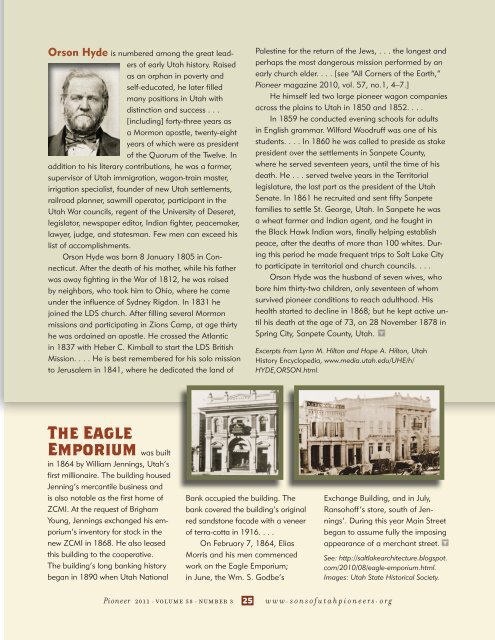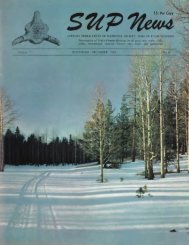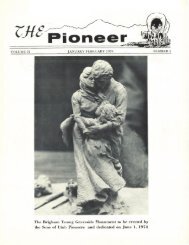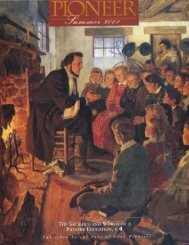Pioneer: 2011 Vol.58 No.3
Create successful ePaper yourself
Turn your PDF publications into a flip-book with our unique Google optimized e-Paper software.
Orson Hyde is numbered among the great leaders<br />
of early Utah history. Raised<br />
as an orphan in poverty and<br />
self-educated, he later filled<br />
many positions in Utah with<br />
distinction and success . . .<br />
[including] forty-three years as<br />
a Mormon apostle, twenty-eight<br />
years of which were as president<br />
of the Quorum of the Twelve. In<br />
addition to his literary contributions, he was a farmer,<br />
supervisor of Utah immigration, wagon-train master,<br />
irrigation specialist, founder of new Utah settlements,<br />
railroad planner, sawmill operator, participant in the<br />
Utah War councils, regent of the University of Deseret,<br />
legislator, newspaper editor, Indian fighter, peacemaker,<br />
lawyer, judge, and statesman. Few men can exceed his<br />
list of accomplishments.<br />
Orson Hyde was born 8 January 1805 in Connecticut.<br />
After the death of his mother, while his father<br />
was away fighting in the War of 1812, he was raised<br />
by neighbors, who took him to Ohio, where he came<br />
under the influence of Sydney Rigdon. In 1831 he<br />
joined the LDS church. After filling several Mormon<br />
missions and participating in Zions Camp, at age thirty<br />
he was ordained an apostle. He crossed the Atlantic<br />
in 1837 with Heber C. Kimball to start the LDS British<br />
Mission. . . . He is best remembered for his solo mission<br />
to Jerusalem in 1841, where he dedicated the land of<br />
Palestine for the return of the Jews, . . . the longest and<br />
perhaps the most dangerous mission performed by an<br />
early church elder. . . . [see “All Corners of the Earth,”<br />
<strong>Pioneer</strong> magazine 2010, vol. 57, no.1, 4–7.]<br />
He himself led two large pioneer wagon companies<br />
across the plains to Utah in 1850 and 1852. . . .<br />
In 1859 he conducted evening schools for adults<br />
in English grammar. Wilford Woodruff was one of his<br />
students. . . . In 1860 he was called to preside as stake<br />
president over the settlements in Sanpete County,<br />
where he served seventeen years, until the time of his<br />
death. He . . . served twelve years in the Territorial<br />
legislature, the last part as the president of the Utah<br />
Senate. In 1861 he recruited and sent fifty Sanpete<br />
families to settle St. George, Utah. In Sanpete he was<br />
a wheat farmer and Indian agent, and he fought in<br />
the Black Hawk Indian wars, finally helping establish<br />
peace, after the deaths of more than 100 whites. During<br />
this period he made frequent trips to Salt Lake City<br />
to participate in territorial and church councils. . . .<br />
Orson Hyde was the husband of seven wives, who<br />
bore him thirty-two children, only seventeen of whom<br />
survived pioneer conditions to reach adulthood. His<br />
health started to decline in 1868; but he kept active until<br />
his death at the age of 73, on 28 November 1878 in<br />
Spring City, Sanpete County, Utah.<br />
Excerpts from Lynn M. Hilton and Hope A. Hilton, Utah<br />
History Encyclopedia, www.media.utah.edu/UHE/h/<br />
HYDE,ORSON.html.<br />
The Eagle<br />
Emporium was built<br />
in 1864 by William Jennings, Utah’s<br />
first millionaire. The building housed<br />
Jenning’s mercantile business and<br />
is also notable as the first home of<br />
ZCMI. At the request of Brigham<br />
Young, Jennings exchanged his emporium’s<br />
inventory for stock in the<br />
new ZCMI in 1868. He also leased<br />
this building to the cooperative.<br />
The building’s long banking history<br />
began in 1890 when Utah National<br />
Bank occupied the building. The<br />
bank covered the building’s original<br />
red sandstone facade with a veneer<br />
of terra-cotta in 1916. . . .<br />
On February 7, 1864, Elias<br />
Morris and his men commenced<br />
work on the Eagle Emporium;<br />
in June, the Wm. S. Godbe’s<br />
Exchange Building, and in July,<br />
Ransohoff’s store, south of Jennings’.<br />
During this year Main Street<br />
began to assume fully the imposing<br />
appearance of a merchant street.<br />
See: http://saltlakearchitecture.blogspot.<br />
com/2010/08/eagle-emporium.html.<br />
Images: Utah State Historical Society.<br />
<strong>Pioneer</strong> <strong>2011</strong> ■<br />
volume 58 ■<br />
number<br />
3 25<br />
www<br />
■<br />
sonsofutahpioneers<br />
■<br />
org







